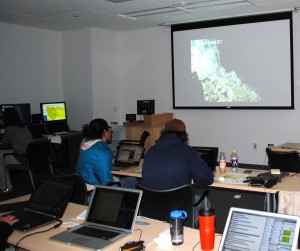The Naval Historical Foundation (NHF) in support of the National Museum of the United States Navy and Naval History and Heritage Command (NHHC) has begun planning and fundraising for three science, technology, engineering, and mathematics (STEM) educational outreach programs for elementary, middle, and high school students. Using museum exhibits and operating spaces at the Washington Navy Yard, NHF is partnering with project Mission Ocean™, sponsoring secondary school STEM-teacher fellowships, and extending outreach to underwater exploration and archeology through the NHHC Archeology Branch and Dr. Robert Ballard at the Institute for Exploration.
The Mission Ocean™ program was developed in 1997 by a team at Purdue University Calumet to help elementary school teachers deliver math, science and technology through collaborative teaching methods based on a deep-sea submarine research and rescue simulation. In coordination with sponsors at Naval Sea Systems Command, the Office of Naval Research, and the National Science Foundation, Mission Ocean™ has expanded in use and scope, focused on higher level elementary school and middle school students. It is an inquiry-based, hands-on program, divided into four modules, consisting of events and activities that introduce students to the key STEM concepts and skills related to submarine operation. Many of the activities incorporate teamwork as a major element.
Mission Ocean™ prepares students to apply science concepts in making sound decisions as they run their mission. Beginning with hands-on activities to learn the basics of ocean measurements, compasses, bearings, headings, charts, soundings, steering, piloting, maneuvering, diving, trimming, surfacing, propulsion energy, and navigation the groundwork is formed to expand and apply these skills to computer-based simulations of surfaced and submerged submarine operations of a four-person exploration sub. The four modules are: Getting Underway Team, Drive Team, Dive Team, and Navigation Team. NHF is working with Purdue University-Calumet and NAVSEA to install a 12-computer Mission Ocean simulation center adjacent to the Covert Submarine Operations Exhibit of the Cold War Gallery in the WNY. The combined computer outputs of the Mission Ocean modules is projected in 3D on a large screen to conduct, observe and evaluate the overall conduct of the mission. This year, four schools in Prince William County, Virginia are using Mission Ocean™ within their school curriculum. They are planning to conduct missions at the WNY in spring 2012.
An NHF sponsored teacher fellowship program for high school STEM teachers was conducted this past summer at WNY, focused on STEM lesson planning for secondary schools. The fellowship program was publicized through numerous educational organizations, Navy Recruiters, and the Troops-to-Teachers programs. Several dozen talented teachers from around the nation applied. Two teams of four teachers were selected. Their task was to use the displays and artifacts in the new Covert Submarine Operations Exhibit to create innovative STEM lesson plans. From a broad range of possible submarine-related topics, including sonar, periscopes, torpedoes, cruise missiles, ballistic missiles, fire control, communications, electronics, nuclear propulsion, ship control, environmental control, and navigation, the teachers developed plans tied to common core and state standards for algebra, geometry, statistics, biology, chemistry, environmental science, technology, and engineering. The plans are hosted on a new website developed for the Cold War Gallery, www.usnavymuseum.org. The website includes all the planned exhibits in the gallery, has a prominent education section, and enables viewers to take tours of the completed and yet-to-be completed exhibits. NHF plans to repeat the teacher fellowships at WNY next summer, expanded to naval aviation, surface warfare, and cold war naval research areas of the exhibit.

Team Rhode Island in the Exploration Command Center watching video streaming from NOAA Ship Okeanos Explorer at the Mid-Cayman Rise. The console and intercom system is on the left of the image and scientists can also communicate with each other and the ship by instant messaging from computers. Image courtesy of NOAA Okeanos Explorer Program, MCR Expedition 2011.
Exploration Command Consoles (ECCs) are the shore site installations that display the live streaming video feeds, audio communications, and data feeds from undersea research ships at sea, including vessels from Dr. Robert Ballard’s Ocean Exploration Trust. ECCs are located at: NOAA Office of Exploration, Silver Spring, MD, NOAA Pacific Marine Environmental Lab, Seattle, WA, Institute for Exploration at Mystic Aquarium, Mystic, CT, University of Rhode Island Inner Space Center, and University of New Hampshire . Installation of an ECC is being planned for the Navy museum at WNY. This console could be used by students as part of NHHC educational outreach through the Underwater Archeology Staff, as well as for dedicated researchers. The Underwater Archeology Branch has recently increased outreach efforts with presentations on underwater archeology to local public schools, lectures at NHHC museums, and a growing internship program. An ECC focusing on cutting edge undersea technology, engineering, and exploration will increase public education initiatives, and is a complementary component to the elementary and middle school Mission Ocean™ program and simulation center.
The combination of expanded, interactive Cold War Gallery exhibits, hands-on undersea operations and research simulations, actual at-sea explorations and research missions, and expanded STEM-lesson planning by expert teachers, using world-wide internet outreach, will provide an expanded educational focus for the National Museum of the United States Navy.


Pingback: Year End Appeal Letter in the Mail | Naval Historical Foundation